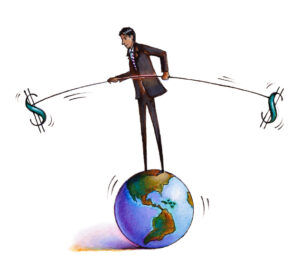“Don’t Be Fooled by Recent Strength… A Post-Dollar World Is Coming”
The comments below are an edited and abridged synopsis of an article by Ruchir Sharma
The value of the US dollar against other major currencies is now 20% above its long-term trend, and above 2001’s peak. Since the 1970s, the typical upswing in a dollar cycle has lasted about seven years; the current upswing is in its 11th year. Moreover, fundamental imbalances bode ill for the dollar.
When a current account deficit runs persistently above 5% of GDP, it signals trouble ahead. The US current account deficit is now close to that 5% threshold.
Nations’ currencies weaken when the world no longer trusts that they can pay their bills. The US currently owes the world a net $18 trillion (73% of US GDP), far beyond the 50% threshold.
Investors tend to move away from the dollar when the US economy is slowing relative to the rest of the world. Recently the US has been growing faster than the median rate for other developed economies, but it is poised to slow.
If the dollar enters a downswing, the question is whether that period lasts long enough, and goes deep enough, to threaten its status as the world’s most trusted currency.
The dollar has been bolstered by the weaknesses of its rivals. The euro has been repeatedly undermined by financial crises, while the renminbi is managed by an authoritarian regime. Nonetheless, alternatives are gaining ground.
Sharma discusses other world currencies and global reserves; the effect of US sanctions on Russia and America’s waning influence over a dollar-driven world; and south-east Asia’s methods of avoiding payments using the dollar.
In closing Sharma writes, “So don’t be fooled by the strong dollar. The post-dollar world is coming.”

